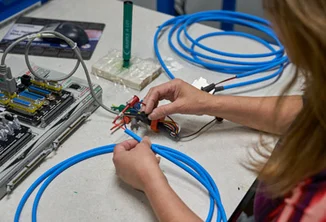Wire harnesses are wire configurations for powering many different electrical devices. To manufacture, some wire harness assembly automation is possible, but other processes of production still rely on manual assembly. The combined process groups wires or cables into a unit that transmits electrical and electronic signals or electrical power that provides a single connection point.
On a basic level, wire harnesses are an organizational method of bundling wires or cables in a thermoplastic or thermoset sheath to manage electrical systems and protect them from the environment. A harness is composed of a complex assembly of straps, lacing, ties, tubing, sleeves, multi-pair and multi-conductor cables, coaxes, and conduits that keep wiring systems and the sum of its components together in an organized and efficient manner.
They are a relatively low cost organizational tool, intended to meet geometric and electrical design requirements of a larger assembly or equipment. The harness houses the wiring that powers components large and small vital in applications found in the automotive and aerospace industry, industrial equipment and machinery, data communications related equipment, durable goods, consumer products, and other electro-mechanical devices.
Wire Harness Manufacturing
 When we think of manufacturing in today’s global economy, we think of advanced smart technologies that provide intelligent, efficient production. A combination of CAD design, simulation, computer modeling, advanced input and output technologies, automation and control techniques. But that’s not the case when it comes to the wire harness manufacturing process. Though computer technology and other modern systems are utilized in the design and pre-assembly stages for creating a wire harness, the actual production still requires more than what automated manufacturing can provide. It requires a personal touch.
When we think of manufacturing in today’s global economy, we think of advanced smart technologies that provide intelligent, efficient production. A combination of CAD design, simulation, computer modeling, advanced input and output technologies, automation and control techniques. But that’s not the case when it comes to the wire harness manufacturing process. Though computer technology and other modern systems are utilized in the design and pre-assembly stages for creating a wire harness, the actual production still requires more than what automated manufacturing can provide. It requires a personal touch.
Processes that CAN’T Be Automated
Following the schematic design to assemble wire harnesses is a manufacturing process still done mostly by hand. Manual production remains the most cost-effective method of assembling wire harnesses because the process of that assembly is too difficult to automate.
Assembling wire harnesses is a step by step procedure. Installing terminated wires in varying lengths or the running of wires and cables through sleeves and conduits must be done manually. Specified wires, when there is more than one wire going into one terminal, requires conducting multiple crimps that have to be done by hand. So does taping the harness with fabric tape at all the branch outs. Finally, the various components need to be bound or “harnessed” by hand with tape, clamps, or cable ties.
Processes that CAN Be Automated
Not every step of wire harness production is done manually, however. In fact, there are some steps that can be automated during assembly of the wire harness. The ends of individual wires that require cutting and stripping can be achieved by specialized cutting machines. Crimping terminals on one or each side of the wires as well as plugging wires that have been previously fitted with terminals into connector housings. Wire ends can also be soldered through automation.
Once assembly is completed, it is tested for electrical functionality. This step is partially automated utilized by a test board designed for the wire harness that allows it to be plugged into the board to check for any electrical faults.
- Cutting
- Stripping
- Crimping
- Plugging
- Some soldering
- Electrical safety testing
Wire harnesses are used for simplifying a configuration of wires that connect to electronic devices. Intricate wire diagrams organize multiple wires to create a harness with a single connection point. In a world dominated by technology, automation and design, production of wire harnesses still, in large part, requires manual assembly.


